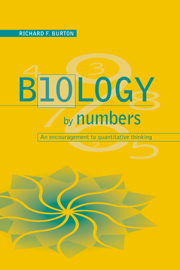Book contents
- Frontmatter
- Contents
- Preface
- A guide to the book
- 1 Putting two and two together
- 2 Units, formulae and the use of old envelopes: confronting some obstacles to quantitative thinking
- 3 Aspects of energy metabolism
- 4 Getting things in proportion
- 5 Perilous percentages, dangerous ratios
- 6 Building a trophic pyramid
- 7 Sodium in animals and plants
- 8 Exchanges of water and carbon dioxide
- 9 A geometric series
- 10 Introduction to logarithms
- 11 Bringing logarithms to life
- 12 Exponential relationships
- 13 Aspects of allometry
- 14 More on allometry, and on quantitative patterns in nature
- 15 How the abundance of food affects rates of feeding
- 16 The characterization of trees and other branching systems
- 17 Epilogue
- References
- Notes
- Index
13 - Aspects of allometry
Published online by Cambridge University Press: 05 June 2012
- Frontmatter
- Contents
- Preface
- A guide to the book
- 1 Putting two and two together
- 2 Units, formulae and the use of old envelopes: confronting some obstacles to quantitative thinking
- 3 Aspects of energy metabolism
- 4 Getting things in proportion
- 5 Perilous percentages, dangerous ratios
- 6 Building a trophic pyramid
- 7 Sodium in animals and plants
- 8 Exchanges of water and carbon dioxide
- 9 A geometric series
- 10 Introduction to logarithms
- 11 Bringing logarithms to life
- 12 Exponential relationships
- 13 Aspects of allometry
- 14 More on allometry, and on quantitative patterns in nature
- 15 How the abundance of food affects rates of feeding
- 16 The characterization of trees and other branching systems
- 17 Epilogue
- References
- Notes
- Index
Summary
Introduction
Despite the seemingly endless variety of organisms, there are limits to their diversity that reveal themselves in quantitative principles. One important idea in quantitative biology is that form and function depend very much on size. Paramecium cannot have relatives inches or feet across. Small dogs are often more active than big ones, and their hearts tend to beat faster. Big animals tend to live longer than small ones, come to maturity later, have a lower annual fecundity and be fewer in terms both of individuals and of species. Very many such empirical relationships between size and function in animals and plants have described.
This chapter and the next touch on such matters as growth, physiology, biomechanics, ecology and trends in evolution, but in mathematical terms they deal with relationships that are mostly of an identical form, a power function such that Y is proportional to Xb. Such power functions are revealed as straight lines when the data are plotted logarithm against logarithm, or on double-logarithmic graph paper (‘double-logarithmic’ or ‘log-log’ plots). The mathematical content here is barely more than in previous chapters, and consists largely of the repeated application of one equation (although that appears in both power-function and logarithmic guises). Beyond that, the various Sections may be read not just for their biology, but for general object-lessons on the interpretation of graphical data, some of which apply equally to linear (non-logarithmic) plots.
- Type
- Chapter
- Information
- Biology by NumbersAn Encouragement to Quantitative Thinking, pp. 133 - 156Publisher: Cambridge University PressPrint publication year: 1998



